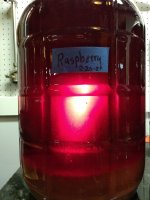I've just made a batch of blueberry and wisteria blossom melomel, started June 18th and racked (2nd time) July 7th. Lalvin 71B yeast, start SG 1.085 end SG 0/992. It's crystal clear and not showing signs of activity now. Got a bit caught out by volume loss to racking - our demijohns in UK are 5L and I think I made a bit over a US gallon originally so there's a lot of headroom and I've run out of glass marbles to fill the space ! It does smell lovely, reminiscent of a Provencal vin gris but with a lot more colour and refreshingly light.
Am I basically safe to bottle this now for ageing rather than leaving it in the demijohn as there'll be less risk of spoilage from excess headroom ? It's about 20 years since I did any fermentations and it was all very non-scientific back then,, I haven't made any meads before, only wine.
Also as per end SG it's bone dry and I reckon the yeast is capable of more, but I don't really want it too strong, it's meant to be a light refreshing summery drink with a hint of sweetness to balance the acidity. Any experiences with using xylitol to back-sweeten ? I'm not keen on Stevia and have next to no experience of artificial sweeteners. This'll likely be used mainly for gifts in half bottles as I don't drink much these days. Anything I need to keep in mind about sensitivities if back-sweetening ?
Thanks
Am I basically safe to bottle this now for ageing rather than leaving it in the demijohn as there'll be less risk of spoilage from excess headroom ? It's about 20 years since I did any fermentations and it was all very non-scientific back then,, I haven't made any meads before, only wine.
Also as per end SG it's bone dry and I reckon the yeast is capable of more, but I don't really want it too strong, it's meant to be a light refreshing summery drink with a hint of sweetness to balance the acidity. Any experiences with using xylitol to back-sweeten ? I'm not keen on Stevia and have next to no experience of artificial sweeteners. This'll likely be used mainly for gifts in half bottles as I don't drink much these days. Anything I need to keep in mind about sensitivities if back-sweetening ?
Thanks



![20220911_163804[1].jpg 20220911_163804[1].jpg](https://cdn.homebrewtalk.com/data/attach/722/722037-20220911-163804-1-.jpg)
